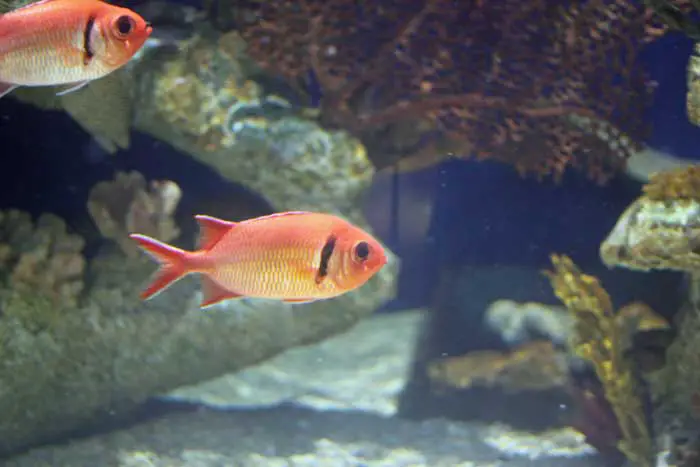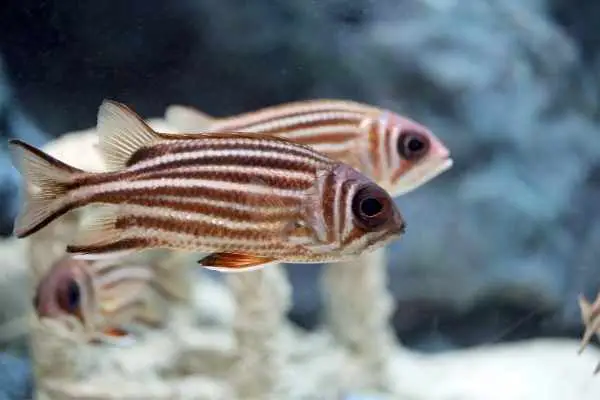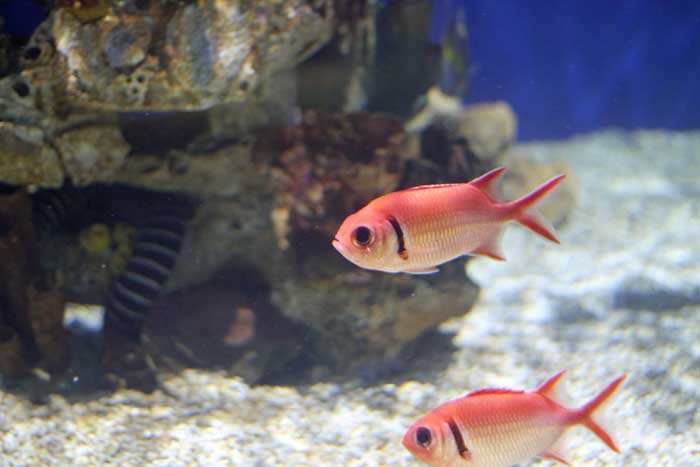Squirrelfish (Family Holocentridae) get their name from their enormous, shiny black eyes. A nocturnal group, those round eyes come in handy when searching for food in low-light levels. And they happen to make them a charming addition to most reef aquariums. But – like the furry mammal they’re named for – squirrelfish come with some surprises, and you’ll want to keep those needs in mind.
Table of Contents: Squirrelfish Care
If you have a particular element of squirrelfish care you’re interested in, you’ll find quick links listed below. However, with over 100 possible species available – each with a few unique quirks – you may want to read the entire article and make sure you’re not missing anything important.
- Quick Facts
- Description of the Squirrelfish
- Squirrelfish Lifespan
- Creating the Ideal Squirrel World
- Squirrelfish Diet
- Squirrelfish Behavior and Tank Mates
- Breeding the Squirrelfish
- Pros and Cons
- For More Information

Quick Facts
- Common Names: Squirrelfish, Striped squirrelfish, Hawaiian squirrelfish, Soldierfish, Candile
- Scientific Names: Family Holocentridae
- Subfamily Holocentrinae (Squirrelfishes)
- Holocentrus spp.
- Neoniphon spp.
- Sargocentron spp.
- Subfamily Myripristinae (Soldierfishes)
- Corniger spp.
- Myripristis spp.
- Ostichthys spp.
- Plectrypops spp.
- Pristilepis spp.
- Size: 7-24 inches (17.8-61cm)
- Minimum Tank Size: 75-100 Gallons (284-379L)
- Reef Safe? With Caution
- Care or Experience Level: Moderate
- Preferred Diet: Carnivore
- Original Part of the World: Indo-Pacific; Southwestern Atlantic; Gulf of Mexico
- Subfamily Holocentrinae (Squirrelfishes)
Description of the Squirrelfish
Whether you’re viewing a soldierfish or squirrelfish, the first thing you usually notice are those big, round eyes. (Actually, the first thing you notice is a fish hiding out in a cave or under a ledge, but that’s beside the point) The eyes take up most of the head in these vibrant red fish, putting some in mind of a fuzzy mammalian squirrel.

As juveniles, aquarists and divers may overlook squirrelfish. While the fish have trademark eyes, they lack the orange to red scales. This is due to an abundance of iridophores. Iridophores reflect light and produce a shimmer effect on fish scales. Since the youngsters spend most of their life hanging out in the upper water column (they’re pelagic), this makes sense. As squirrelfish transition into their adult growth, the chromatophores take on more of the red pigments the group is known for. And it coincides with the adults returning to a coral-based life. The red and orange scales let them blend into the corals they use for a home base during the day.
Squirrels possess spines along the dorsal fin and the gill cover. When threatened by predators, they spread them to look more threatening. And some of the genera take that a step further. The Holocentrinae carry venom in the spines on their opercular spines. But since they aren’t the bravest fish in the world, they use that venom as a last resort.
Currently, 150 species of squirrelfish have been described. But only a few are kept by aquarists. The most popular include:
- Holocentrus adscensionis (Big-eyed squirrelfish)
- Holocentrus rufus (Long-spine squirrelfish)
- Neoniphon sammara (Sammara soldierfish)
- Neoniphon argenteus (Clear-fin soldierfish)
- Sargocentron diadema (Crown squirrelfish)
- Myripistis murdjan (Big-eye soldierfish)

Squirrelfish Lifespan
Squirrelfish prefer the tropical and subtropical waters of the Atlantic and Pacific regions. They stretch from the West Indies and Caribbean through the Gulf of Mexico. And on the opposite side of the globe, they’re seen throughout Fiji, Hawaii, and across the Pacific reefs. They’re plentiful and feature as an important protein source in many cultures.
This is probably why they don’t have the most impressive lifespan in the aquatic world. You’ll see them living between 2-4 years, even under ideal conditions. They’re predators in their own right, but they also serve as prey for plenty of species.
Creating the Ideal Squirrel World
In the wild, squirrelfish stay near rocky habitats and coral reefs. Some species dive as far as 600 feet (183m), but most stay under 100 feet (30m). They prefer their water as warm as possible (which is why you find them in the tropical belts). And while you don’t need to fret over matching your corals to their orangish-red scales, you WILL need to make sure your marine tank gets set up to make them as comfortable as possible.
Squirrels need caves and ledges. This is where they hang out during the day. It keeps them safe from potential predators AND the bright light of the sun. Those enormous eyes work for nocturnal viewing – where the light is dim. Especially the species that dwell at depth, they can’t handle the brilliance of a tropical day.
You’ll want to provide overhangs large enough to fit your squirrelfish. And if you have a group? The cave or ledge needs to accommodate everyone. This provides extra reassurance among this skittish fish group. If you don’t offer a space for your nocturnal fish to hide during the day, you’ll create unnecessary stress. (You can’t teach them to become diurnal) And try to go easy with your lighting choices. You don’t want to deprive your corals or anemones of their needs, but too much can cause problems. Less is more with these big-eyed fish.

Or you CAN create a nocturnal tank. It involves setting up the correct lighting within your marine tank and choosing appropriate tank mates. You also need to have care with the lighting in the room where your aquarium resides. It’s more work, but it’s rewarding. And you’ll get to enjoy the activity of your nocturnal fish during YOUR waking hours.
Squirrelfish Tank Size
Squirrelfish aren’t the most active fish in the world – even at night. They come out to forage, but they aren’t performing strenuous laps. And they’re not explorers. So when you set out to choose a tank size, it’s the fish that makes the difference. Some species – such as the big-eyed squirrelfish – grow up to 24 inches (61cm). Others only grow as long as 7 inches (18cm) as adults.
You also need to consider the fact that some squirrels prefer to live in groups. Others? They’d rather stay on their own. And, of course, if you’re planning to set up a community, you need to take all of THOSE fish into consideration. On average, you can get away with tank sizes between 75-100 gallons (284-379L). But research your species carefully FIRST. The last thing you want is a squished squirrel.
Are Squirrelfish Reef-Safe?
Squirrelfish use reefs as their home base. That makes them the ideal reef-safe fish for saltwater aquariums. However, it comes with a caveat. These big-eyed fish are carnivores. And they have a big mouth to boot. If something fits in their mouth, they’ll eat it. This means any shellfish. So if you have cleaner shrimp in your tank, they’re at risk of becoming a midnight snack (literally).
Squirrels also use their powerful upper jaws to dig in the substrate to find food. This can disperse sand into the water column, which may cause problems for your coral polyps. As long as you’re providing enough food, you can prevent the digging. But keep an eye on things.

Squirrelfish Diet
Whether you have soldierfish or squirrelfish, they enjoy the meaty things in life. Setting out at night, they search for invertebrates, meroplankton, and even fish. If something fits in their mouth, they’ll try to eat it. This SHOULD make them easy to handle.
However, when you first bring a squirrel home, they may be too nervous about venturing out of hiding. You’ll need to consider offering them live feeder shrimp with tongs. That should entice your new nocturnal acquisition to pick up their usual routine.
But don’t let them get used to the feeder shrimp! You want to vary things to prevent them from getting fat. Chopped marine meats and freeze-dried shrimp work, too. Variety will keep those red pigments looking sharp. And it will prevent unwanted destructive behaviors – such as snacking on other inhabitants in the tank.
Squirrelfish Behavior and Tank Mates
Color isn’t the only thing that shifts as squirrelfish age – so does their social dynamic (in most species). While they’re vulnerable juveniles, they hang out in schools. The shoal provides protection and allows everyone to hunt in safety. But as they get older, everyone ventures out on their own to form an individual territory. And some species? They’d prefer to live in a tank without any other squirrelfish – or soldierfish – in the mix.
And they KNOW when another fish with enormous eyes is around. Squirrels are one of those groups that communicate via the swim bladder. The vibration of the muscles around the organ produces various sounds, and they range in frequency from 75-85Hz. So it’s not unheard of for aquarists to pick up noises from their marine tank when they have more than one squirrelfish in residence.
The same swim bladder sensitivity makes it easy for these fish to “hear,” too. The swim bladder lies close to the inner ear. That means it’s nothing for electrical signals to travel between the two. It’s an important trait when you’re on the menu for so many larger, hungrier fish.
If you want to keep more than one squirrelfish or soldierfish in the tank, you MUST provide enough room. And that means cave and ledge space, too. You can’t let anyone stay out in the “cold.” If you see the flexing of those spines, it’s a sign that your fish feels threatened. And a threatened squirrel is a stressed squirrel.
Otherwise, these round-eyed beauties do well with a surprising number of fish. You’ll need to consider the size, of course. But they’ll get along with anyone who won’t harass them during the daylight hours:
- Angelfish
- Filefish
- Frogfish
- Goatfish
- Groupers
- Hamlets
- Lionfish
- Parrotfish
- Puffers
- Rabbitfish
- Scorpionfish
- Surgeonfish
- Triggerfish

On the other end of the scale, you’ll want to avoid any tank mates your squirrelfish can fit in their mouths, even if they’re nocturnal or well-behaved. Like most crustaceans, it’s asking for the worst to happen.
- Anthias
- Assessors
- Blennies
- Cardinals
- Damsels
- Dottybacks
- Gobies
- Grammas
- Jawfish
- Pipefish
- Seahorses
- Tilefish
Breeding the Squirrelfish
Attempting to breed squirrelfish in captivity gets tricky. Not because of tank size needs or aggression – as you can see with other species. No, it’s more to do with the way the fry develop. And because trying to sex males and females is nearly impossible. They look the same. The only difference? Females are SLIGHTLY larger. A difference of about 10mm. (Feel free to break out the calipers)
Squirrels like warm water. In tropical regions, spawning happens year-round. In subtropical areas, it only occurs during the summer. There’s no parental care (not that that’s unusual in the aquatic world). The parents undergo batch spawning. Females release anywhere from 50,000-250,000 eggs into the open water. It sounds insane, but the majority of those eggs won’t survive to become adult squirrelfish.
The fry are thin, silvery fish that enjoy a pelagic existence for the first 70 days of their lives. Of course, they also end up as food for plenty of other organisms during that time. It isn’t until after that period that they move closer to shore and start to settle onto a reef. And even then, they’re only 1 inch (2.5cm) long. Squirrels DON’T grow fast. Attempting to replicate this stage in a captive setting is nearly impossible – certainly for the hobby aquarist.

Pros and Cons
Who can resist the enormous eyes of a squirrelfish? And while they may not be the most demanding fish out there, it’s important to consider all aspects of bringing one into your reef tank:
Pros
- There are over 100 species of squirrelfish to choose from, divided into two subfamilies.
- Squirrels are hardy fish. They’re resistant to most diseases found in home aquariums.
- As long as you provide suitable ledges and caves for these nocturnal fish to hide within during the day, they aren’t concerned about your tank décor.
Cons
- Squirrelfish have dorsal and opercular spines. This means they can get caught in nets – or even catch on YOUR hands. If broken, the spine may quickly become infected.
- Due to their nocturnal nature, you need to keep the lighting dim or consider setting up a nocturnal aquarium if you want to watch the activity of your squirrels.
- Squirrelfish fry spend 70 days in pelagic waters before coming inshore to settle on the reef, making it nearly impossible to breed them in captivity.
For More Information
Watching nocturnal fish engage in their usual behaviors during the day gets tricky. You have to make special preparations – or you need to stay up late. But that doesn’t stop aquarists from adding squirrelfish to their collections. And it won’t stop you from wanting to learn more about them!
This YouTube video demonstrates the shrimp-feeding technique you may need to take with a new squirrelfish.
Want to learn more about the best squirrel tank mates?
- Bicolor angelfish
- Coral beauty angelfish
- Flame angelfish
- Dwarf lionfish
- Dogface pufferfish
- Foxface rabbitfish
- Picasso triggerfish
Those spines can cause plenty of problems. Other fish may also have troublesome spines. Why not learn about them, as well?
Want to understand why these reef dwellers won’t work with squirrelfish? With further research, the picture will come clear. (Or you may find a new fish friend!)
- Lawnmower blenny
- Midas blenny
- Starry blenny
- Tailspot blenny
- Banggai cardinalfish
- Pajama cardinalfish
- Blue devil damselfish
- Domino damselfish
- Yellowtail damselfish
- Diamond goby
- Engineer goby
- Firefish goby
- Mandarin goby
- Neon goby
Conclusions
Okay, so it seems odd to name a fish after a mammal (especially a mammal that ISN’T nocturnal). But squirrelfish make attractive additions to any reef tank. Even if you don’t set up a nocturnal aquarium, you can still peek in at them in their caves. And if you stay up a touch late, you’ll get a chance to see them foraging for food. They’re a unique attraction with particular adaptations, even if you have to sacrifice keeping crustaceans in the same reef tank.
References
- Carlson, B.A. and Bass, A.H. 2000. “Sonic/Vocal Pathways in Squirrelfish (Teleostei, Holocentridae).” Brain Behavior and Evolution.
- Keene State College Students. “Squirrelfish.” A Student’s Guide to Tropical Marine Biology.
- Randall, J.E. 1998. “Revision of the Indo-Pacific Squirrelfishes (Beryciformes: Holocentridae: Holocentrinae) of the genus Sargocentron, with Descriptions of Four New Species.” Bernice Pauahi Bishop Museum.


Leave a Reply